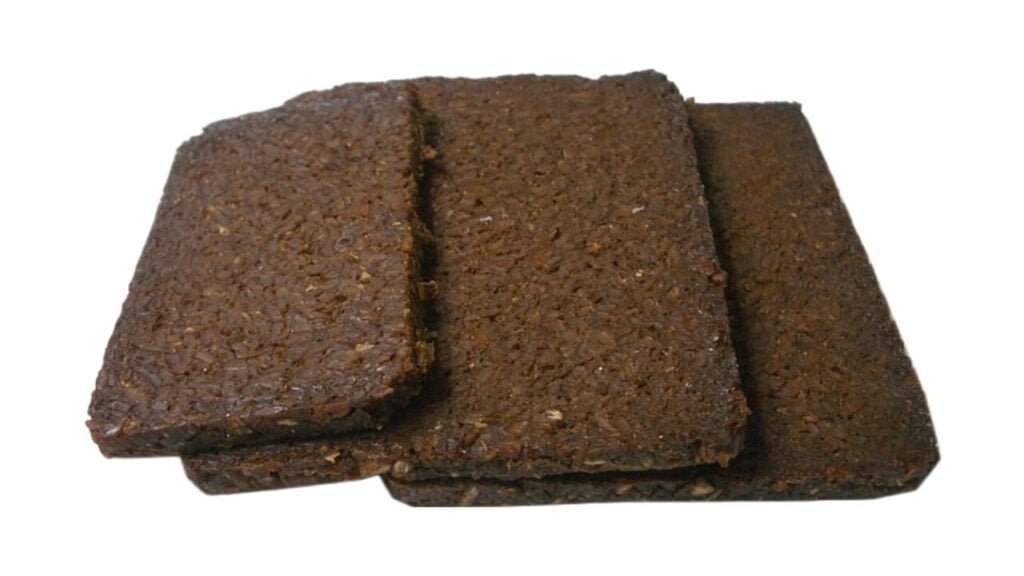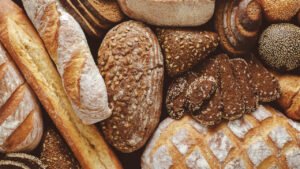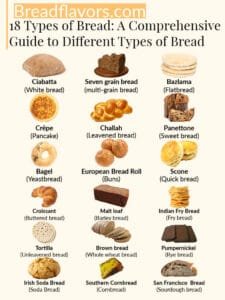
What is pumpernickel? How is it made of? What are its uses, origin, and how to store it?
Whatever the questions you have about this German bread. In this article, we’ll explore everything you need to know about pumpernickel bread, from its history and origins to its basic ingredients and taste, as well as how it differs from rye bread and why it has a unique color compared to other types of bread. Plus, you’ll find out if it’s really as healthy as some claim. Read on for 13 essential things you should know about pumpernickel bread, maybe it will become your new favorite!
What is Pumpernickel Bread?
It is a traditional German rye bread made from coarse ground rye, or a combination of rye flour and whole rye grains with a sourdough starter. It originates from Westphalia, a region in the northwest of Germany.
Traditionally, German pumpernickel bread is made with a dough that is kneaded for a long period without artificial coloring or preservatives, then baked for up to 24 hours at a low temperature. This long baking process gives the bread its dark brown color, slightly sweet, earthy flavor and dense texture.
What is The History and Origin of Pumpernickel?
Pumpernickel bread, originating from Westphalia, Germany in the 15th century, was initially produced by Westphalian farmers using coarsely ground rye flour and a slow baking process that resulted in a dark, dense bread. This bread eventually became known as pumpernickel.
Over time, commercial bakeries adopted pumpernickel bread and spread it beyond Westphalia, where it became popular throughout Germany, Europe, and North America.
While traditionally made with coarse rye flour, most commercial pumpernickel bread contains wheat flour, yeast, molasses, and caraway or anise seeds. Pumpernickel remains a staple bread, closely linked to its origins and history, Germans often slice it and pair it with seafood and other expensive dishes.
Where Does the Name Come From?
The name “Pumpernickel” likely comes from an old Bavarian term meaning hard and it is a combination of two words according to the German dictionary of Johann Christoph Adelung:
“Pumper” which is an old German word for flatulence, while “nickel” is a mischievous fictional character usually associated with the devil or goblin.
The two words are used together to describe this coarse, hard, hard-to-digest bread. The word is thought to have been coined in reference to the difficult digestion and farting of pumpernickel bread.
What is Pumpernickel Bread Made Of?
Pumpernickel gets its distinctive dark color and strong flavor from a long, slow baking process and the high proportion of rye in the dough. The ingredients are simple: a combination of rye flour and whole rye grains, water, salt and sourdough starter from rye.
After mixing the dough, bakers shape the dough into a rectangular loaves and place them in steam-injected oven at low temperatures for up to 24 hours. At this stage, steam plays an important role in the production of traditional pumpernickel bread, allowing it to develop its complex flavors, as well as turns the crust from turning black, while maintaining a moist texture. The result is sourdough bread with an intensely earthy, slightly sweet flavor unlike any other.
Authentic German pumpernickel may seem heavy, but it’s surprisingly light for such a brown bread.
What Does Pumpernickel Taste Like?
Pumpernickel has an earthy, slightly sweet flavor with a hint of acidity, and its dense, moist texture is nothing like regular sandwich bread. Some compare the taste of pumpernickel to dark stout beer or rich dark chocolate.
But for a true taste, look for a real German-style bread recipe made with whole-grain rye and a sourdough starter like this one from the bread she bakes. Some commercial pumpernickel bread may contain wheat flour and some colorful additives, making it lack the strong flavor of the traditional recipes.
Is Pumpernickel Bread Good for You?
Similar to other rye bread types, Pumpernickel bread can be part of a healthy diet due to its richness antioxidant and fiber that aids in digestion and satiety. A regular slice of this dense, dark bread has 2 grams of fiber, which is 7% of your daily requirement according to UCSF Health.
Since the complex carbohydrates in pumpernickel bread have a low glycaemic index, meaning they won’t spike your blood sugar, it’s a good choice for diabetics and anyone on a low-GI diet. Studies show that eating more low-GI foods can help with weight management and reduce the risk of heart disease.
In addition to its nutritional benefits, pumpernickel also contains a variety of vitamins, including B vitamins and magnesium, which support a healthy metabolism and nervous system, and manganese, which helps metabolise carbohydrates and cholesterol.
Is Pumpernickel Gluten Free?
Pumpernickel is made from ground rye berries and sometimes whole wheat flour, which both contain gluten. However, if you avoid gluten, you can find some bakeries and brands offer a gluten-free version of this bread which made from alternative flour types like brown rice flour. But keep in mind, These versions typically lack the robust, full-bodied flavor of the traditional pumpernickel made with sourdough starter.
How It’s Different from Rye Bread
While both rye bread and pumpernickel bread are made with rye flour and share almost the same benefits. Pumpernickel is a darker, denser, more robust bread that gets its unique character from the use of rye flour and grain and the long, slow baking process. In contrast, rye bread is typically made with a lighter rye flour and baked for a shorter time, resulting in a milder, softer loaf.
Variations of Pumpernickel
There are two varieties of pumpernickel bread, if we do not include the North European version of rye bread such as Rugbrød and Ruisleipä , which is very similar to the German rye bread version.
German pumpernickel

Made with rye sourdough starter and a combination of rye flour and whole rye grain, German pumpernickel is baked at low temperature around 250°F for a long period. this slow traditional baking method allows the bread to develop its distinct, tangy flavor and dense, chewy texture.
American pumpernickel

Pumpernickel is widely used in North America, especially in the United States, where it can be used as sandwich or sourdough bread and bagels. Unlike the traditional process, the American variety is made without rye sourdough starter and is often made with other types of flour such as whole wheat and white flour and coloring agents like molasses and cacao powder.
Uses of Pumpernickel

Pumpernickel is extremely versatile and suitable for any meal, from breakfast and dinner to snacks and desserts, and works well with both sweet and savory fillings:
You can usually use pumpernickel bread in any sandwich recipe that calls for white bread, and it’s also one of the best breads to use for grilled cheese. Some of the filling options that go well with it, are pastrami, corned beef, Swiss cheese, or egg salad. If you prefer something sweeter, try it with pumpkin Cream Cheese, jam, or chocolate.
To make great appetizer use traditional pumpernickel with rustic tomato basil bruschetta or a hanky panky recipe. To get more inspired, check out the 10 Best Pumpernickel Bread Appetizers from Yummly.
For breakfast or brunch, you can use pumpernickel bread to make bread pudding, as well as one of the best breads for French toast. As with rye bread, the flavors of pumpernickel read work well with cinnamon, maple syrup, and custard. Less common uses include breadcrumbs, croutons, and stuffing.
Can you toast pumpernickel Bread?
Absolutely! Toasting pumpernickel brings out its malty, slightly sweet flavor. Toast Pumpernickel bread just as you would any other bread; the toasting process brings out nuances in its flavor that can be even more enjoyable than its traditional dense, chewy texture.
How to Store Pumpernickel?
Proper storage of this hearty, dark bread will allow you to enjoy it at its freshest. To keep the bread fresh for as long as possible, follow these tips:
Wrap it in a bread bag, bread box, or place it in a bread container to prevent exposure to air, which accelerates staling. For the best quality, eat pumpernickel bread within 3 to 5 days. However, when stored properly at room temperature, pumpernickel bread can last up to 1 week. Check for signs of spoilage before eating, such as mold, unpleasant odors, or sour taste.
As with all kinds of bread, freezing pumpernickel bread is the best way to extend its shelf life. Wrap slices or whole bread in plastic wrap, aluminum foil, or zip-lock bags and freeze for up to 3 months. When you’re ready to eat, simply defrost the bread in the microwave on the defrost setting, checking it periodically as it defrosts, and turning it over at least once, and do not refreeze it.
Pumpernickel Bread Recipe
You only need a few ingredients to make a pumpernickel bread recipe: Rye sourdough starter, whole rye berries, cracked rye, and salt. For a step-by-step guide, consider visiting this traditional recipe from Taste Atlas. For a simple version made with colors and flavors as well as yeast, try this easy recipe from All Recipes.




